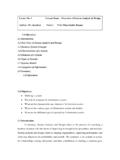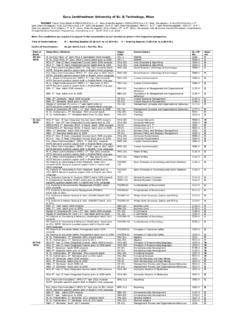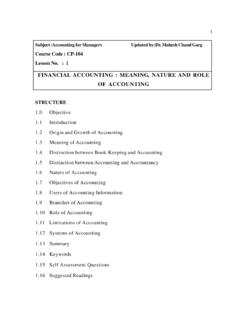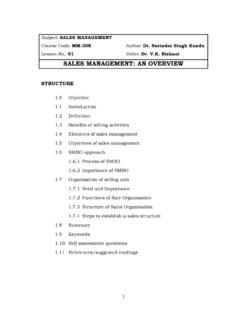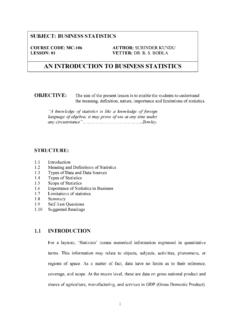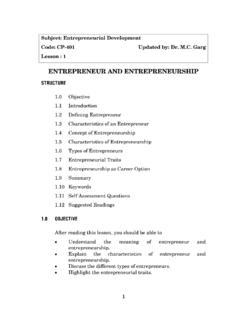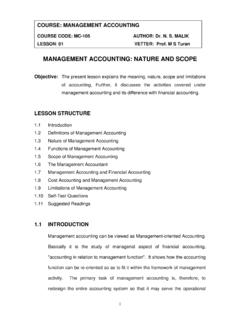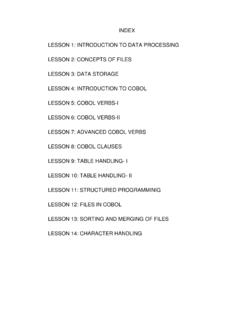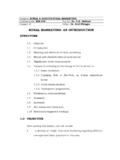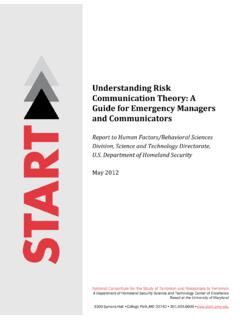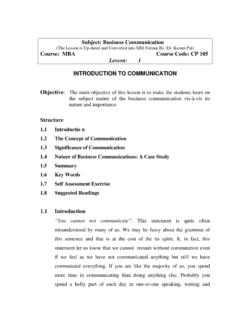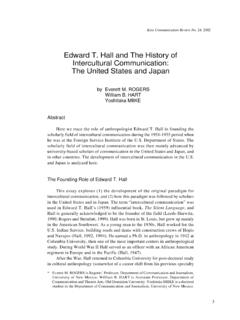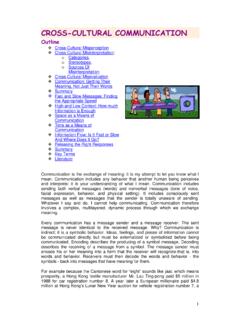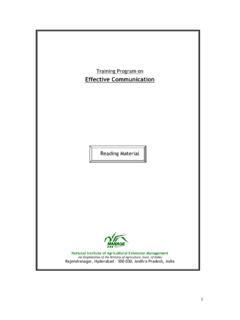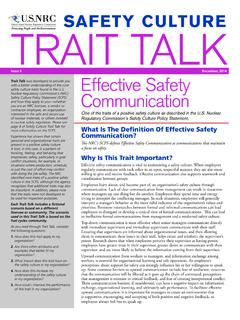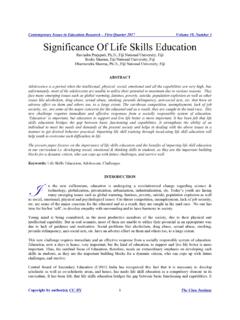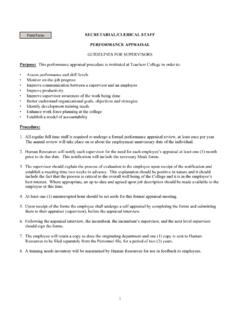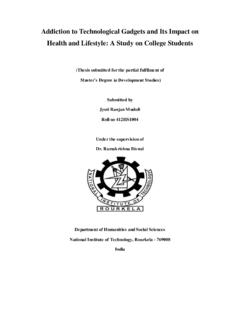Transcription of COMMUNICATION AND ITS SIGNIFICANCE
1 1 Subject: Business COMMUNICATION Course Code: BBA-206 Author: Dr. Bodla Lesson: 1 Vetter: Dr. Karam Pal COMMUNICATION AND ITS SIGNIFICANCE STRUCTURE Objectives Introduction Meaning of COMMUNICATION The COMMUNICATION situation The COMMUNICATION process Objectives of COMMUNICATION SIGNIFICANCE of COMMUNICATION in business Summary Keywords Self assessment questions References/suggested readings OBJECTIVES After going through this lesson, you should be able to- Define COMMUNICATION and business COMMUNICATION . Understand the process of COMMUNICATION . Explain nature and SIGNIFICANCE of business COMMUNICATION . INTRODUCTION We are living in a world which is totally networked with COMMUNICATION .
2 With the advent of fast technology, the world has become a global village. The information sharing among various groups in society at national and international levels has become very smooth, 2 effective and efficient. With the click of small button on computer, you can easily get any information according to your needs and choice. You cannot just think of a world or situation where there is no exchange of ideas, feelings, emotions, reactions, propositions, facts and figures. From time immemorial, COMMUNICATION has been the most important activities of the human lives. The integration of the world economy has been made possible with strong and efficient channel of COMMUNICATION . The nature of COMMUNICATION has gone a significant change during the last dealers. Now the economic power lies in the hands of the countries having very sound information technology network.
3 COMMUNICATION is important from the point of view of understanding it in terms of a process, system, interactional base and structuring. There are various objectives of COMMUNICATION in business organisations. MEANING OF COMMUNICATION There are various definitions and meaning interpreted by different scholars. Matthews says that COMMUNICATION is something so difficult that we can never put it in simple words. But we do need a definition to understand the concept. In his book COMMUNICATION in Business, Peter Little defines COMMUNICATION as the process by which information is transmitted between individuals and/ or organizations so that an understandable response results. Newman and Summer Jr. defines COMMUNICATION as, COMMUNICATION is an exchange of facts, ideas, opinions, or emotions by two or more persons.
4 Obviously, information is the key word in the first definition. But this definition does not indicate the objects about which information is to be transmitted. This is precisely what is provided in the second definition. COMMUNICATION transmits information not only about tangible facts and determinable ideas and opinions but also about emotions. When a communicator passes on or transmits some information, he may 3 also, either intentionally or unconsciously, be communicating his attitude or the frame of his mind. And sometimes the latter may be more relevant to the reality that is being communicated. The following definition offered by William Scott in his book Organisation Theory should appear comprehensive and specially satisfying to the students of business COMMUNICATION since it touches all aspects of the COMMUNICATION process: Administrative COMMUNICATION is a process which involves the transmission and accurate replication of ideas ensured by feedback for the purpose of eliciting actions which will accomplish organizational goals.
5 This definition emphasizes four important points: 1. The process of COMMUNICATION involves the COMMUNICATION of ideas. 2. The ideas should be accurately replicated (reproduced) in the receiver s mind, , the receiver should get exactly the same ideas as were transmitted. If the process of COMMUNICATION is perfect, there will be no dilution, exaggeration or distortion of the ideas. 3. The transmitter is assured of the accurate replication of the ideas by feedback, , by the receiver s response which is communicated back to the transmitter. Here it is suggested that COMMUNICATION is a two-way process including transmission of feedback. 4. The purpose of all COMMUNICATION is to elicit action. It is quite comprehensive definition and covers almost all aspects of COMMUNICATION . But two comments can be made on it: 1.
6 The concept of ideas should be adequately enlarged to include emotions also. 4 2. Even in administrative COMMUNICATION the purpose may not always be to elicit action. Seeking information or persuading others to a certain point of view can be equally important objectives of COMMUNICATION . THE COMMUNICATION SITUATION The COMMUNICATION situation can exist in any of the following four components: 1. There is a person (sender or transmitter) desirous of passing on some information; 2. There is another person (receiver) to whom the information is to be passed on; 3. The receiver partly or wholly understands the message passed on to him; and 4. The receiver responds to the message, , there is some kind of feedback. Two gentlemen greeting each other with folded hands constitute a COMMUNICATION situation, for (a) there is a person desirous of sending a message (greeting); (b) there is another person to receive this message; (c) when the first person folds his hands, the second one understands that he is being greeted; and (d) the second person immediately responds back by folding his own hands.
7 But if an English speaking person addresses a Hindi-speaking person in English, the COMMUNICATION situation does not exist, for though there is a person desirous of sending a message, the message is not understood and consequently there is no feedback. 5 THE COMMUNICATION PROCESS How do we describe COMMUNICATION process? The transmission of the sender s ideas to the receiver and the receiver s feedback or reaction to the sender constitute the COMMUNICATION process . The main steps of this cycle are as follows: 1. Input : the information or ideas the sender wants to give the receiver. 2. Channel : letter, fax, phone call, electronic mail, etc. 3. Message : the actual message that is sent. 4. Output : the information the receiver gets 5. Feedback : the receiver s response (or non-response) to the message 6. Brain drain : the possibility of misunderstanding at any step (or Breakdown) We can illustrate this process with the help of the following illustrations: SENDER Input Channel: message RECEIVER Output Idea Letter, fax, phone call, E-mail, etc.
8 Idea Feedback Brain drain Brain drain Brain drain FIG. : COMMUNICATION PROCESS There are several barriers to the understanding of a message, and, as the figure suggests, misunderstanding can occur at any stage. Let us take the following illustration : 6 Input: I want to know the balance in my current account at the end of October. Message: Kindly send me a statement of my transactions in current account No.. during October. Output: He needs a statement of his transactions in current account No.. during October. Feedback: A statement of the transactions is issued. If the action desired in the message is satisfactorily performed or the information is faithfully received (ensured by the feedback), we say the COMMUNICATION loop has been closed.
9 But breakdowns in the COMMUNICATION cycle are quite frequent. The breakdown may be due to one or more of the following: Improper formulation of the message in the mind of the sender; Improper statement of the information in the message; and Improper statement of the message by the receiver. OBJECTIVES OF COMMUNICATION The main objective of all communications in an organization is the general welfare of the organization. Effective COMMUNICATION is needed at all stages in order to ensure this welfare. At the planning stage, information is needed on the various aspects of the enterprise, the feasibility of the project being undertaken, finances involved, manpower required, marketing conditions, publicity campaigns, etc. At the execution stage, orders are issued to the employees to start work, the workers associated with the project are constantly motivated and kept involved, a sense of discipline is cultivated among them and their morale 7 is kept high.
10 All this requires constant two-way COMMUNICATION between the managers and the employees. Then at the assessment stage, the manager is again required to communicate with various sources, both internal and external, to assess the success of the project, and if a need is felt, to envisage modifications in the future plans. In view of this elaborate and complex commercial structure, COMMUNICATION can be used for any or more of the following objectives: Information Education Advice Warning Order Raising morale Suggestion Motivation Persuasion Information Passing or receiving information about a particular fact or circumstance is one of the most important objectives of COMMUNICATION . It can be done either through spoken or written language or by using any other system of signs or signals.

